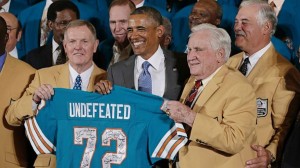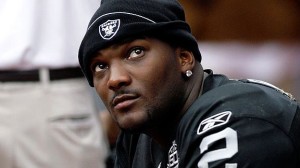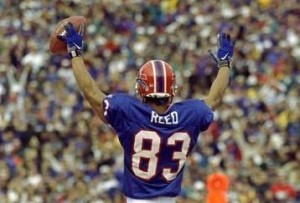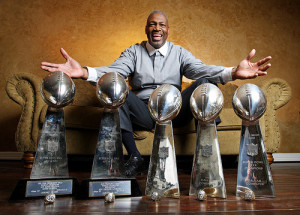Posted on
January 30, 2014 by
Dean Hybl
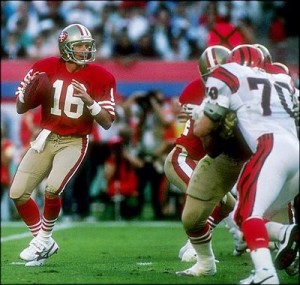
Has there ever been a better Super Bowl performance than Joe Montana in Super Bowl XXIII?
Sunday’s Super Bowl will feature the most prolific offense in NFL history against a squad that has a dominant running back and budding star at quarterback. Who will rise as the greatest star of the biggest game of the year? While Super Bowl history is full of second tier players having a career day, it is also full of future Hall of Famers who rose to the ultimate occasion.
This article marks part two of our look at the top 50 individual offensive performances in Super Bowl history. Of the 50 performances picked for the list, 31 were by players who either are in the Hall of Fame or should realistically expect to receive a bust in Canton at some point. However, when you look at the “best of the best” performances, 19 of the top 25 were by players who are Hall of Fame caliber.
So, as we look toward Sunday, expect the cream to rise to the top and the top performers to be from marquee players like Peyton Manning, Marshawn Lynch, Demaryius Thomas, Wes Welker and Russell Wilson. However, I wouldn’t put it past Julius Thomas, Eric Decker, Golden Tate, Percy Harvin or Doug Baldwin to emerge as a Super Bowl hero.
Here is a look at our picks for the 25 best individual offensive performances in Super Bowl history. For this list we looked at statistics, but also considered game situations. That is why the Super Bowl where Joe Montana threw 5 touchdowns was highlighted in the first look at performances 50-26 and two others where he arguably wasn’t as statistically dominant are included here. We did take into account whether the team won the game, but did not give any weight to who won the game MVP Award as there have been many occasions where you can scratch your head at who received that award.
Be sure to check out part 1 with numbers 50-26. I welcome your comments or ideas as to which performances you think should be on this list.
25. Joe Montana – San Francisco 49ers – Super Bowl XIX – 24-35, 331 yards, 3 TD, 0 INT; 5 rushes, 59 yards, 1 TD
Even though Joe Montana already had a Super Bowl ring prior to facing the Miami Dolphins in Super Bowl XIX, he was generally considered the “second quarterback” entering the big game. Conventional wisdom was that Miami’s big armed quarterback Dan Marino was going to blow away Montana and the 49ers. As it turned out, Montana and his team proved dominant in a 38-16 victory. Montana passed for 13 more yards and tossed three touchdowns with no picks, compared to one TD and two interceptions for Marino.
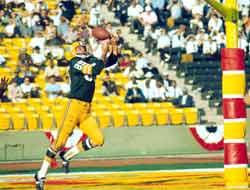
Max McGee was an unlikely hero in Super Bowl I.
24. Max McGee – Green Bay Packers – Super Bowl I – 7 rec., 138 yards, 2 TD
It was no surprise that the Green Bay Packers defeated the Kansas City Chiefs in the first Super Bowl, but it was quite a shocker that one of the stars of the game was aging wide receiver Max McGee. Having caught just four passes in limited action during the season, McGee expected his biggest score of the weekend to be when he broke curfew the night before the game. Yet, after Boyd Dowler suffered a broken collar bone in the first minutes, McGee made history by scoring the first touchdown in Super Bowl history.
23. Kurt Warner – St. Louis Rams – Super Bowl XXXIV – 24-45, 414 yards, 2 TD, 0 INT
Before the 1999 season Kurt Warner had thrown all of 11 passes in the NFL. In Super Bowl XXXIV he threw the ball 45 times for 414 yards (still the single game Super Bowl record) to lead the Rams to a 23-16 victory over the Tennessee Titans. The Rams marched up and down the field, but were held to just three field goals in the first half and the Titans came all the way back to tie the score at 16. Warner then connected with Isaac Bruce for a 73-yard touchdown that proved to be the game winner.
22. Eli Manning – New York Giants – Super Bowl XLVI – 30-40, 296 yards, 1TD, 0 INT
With his team trailing 17-9 after the New England Patriots scored on the first drive of the second half, Eli Manning completed 17 of 23 passes for 176 yards to lift the New York Giants to their second Super Bowl victory over the Patriots in five years. He was especially impressive when marching the Giants down for the game-winning touchdown as he completed five of six passes for 74 yards.
21. John Elway – Denver Broncos – Super Bowl XXXIII – 18-29, 336 yards, 1TD, 1INT; 1 rushing TD
In his final NFL game, John Elway went out in style by passing for 336 yards and a touchdown and scoring another touchdown on the ground as the Broncos won their second straight Super Bowl. The Broncos seized control early with Elway’s 80-yard touchdown pass to Rod Smith giving them a 17-3 lead. Read the rest of this entry →
